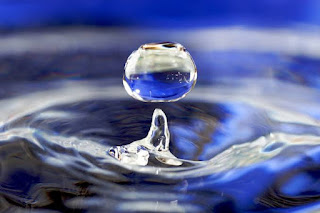Climate Change and its influence on human health
Climate change affects human health in various and many ways, some of which I look at below.
Climate change causes erratic and unpredictable
weather patterns. Some places become colder, others wetter, others drier,
mostly outside the normal times. In terms of human health, weather patterns
will affect the life cycles of pathogens and population, breeding patterns and abundance
of vectors.
 |
| a doctor and a patient - courtesy of dhmri |
 |
| A female anopheles mosquito - image courtesy of cdc |
Mosquitoes thrive in humid and hot areas. They especially love stagnant water or bushy areas. That means that places prone to floods which stagnate in a given area are likely to experience a spike in the number of malaria infections after a few weeks. If an area for example receives a lot of unexpected rainfall in summer or the dry season, then people will start getting sick with malaria sooner than later.
If an area experiences flooding unexpectedly and the water table rises rapidly then you can expect effluent from septic tanks and toilets to mix with ground and even surface water which in turn will contaminate drinking water leading to such diseases as cholera. In large scale. Epidemics.
Landfills in contact with rising ground water and
surface water will cause heavy metal poisoning negatively affecting human
health.
Again in flooded areas, incidences of waterborne diseases such as bilharzia will increase as the water snail finds ideal conditions and multiplies rapidly. Waterways with high velocity are also likely to increase the occurrence of river blindness.
If hot and dry conditions persist for longer than
normal, this will negatively affect agriculture and thus food security. Diseases
linked to lack of adequate nutrition will persist and even blossom (this isn’t
a good thing). Cue kwashiorkor, malnutrition, rickets, scurvy (this used to
belong to sailors) etc.
Wildfires as a result of prolonged high temperatures
and dry conditions will lead to emission of very minute ash and particulate
matter, which is easily breathed in and would cause respiratory problems.
Respiratory diseases are also likely to multiply in dry and dusty areas. Such conditions will slowly invade new areas, as desert conditions continue to colonize arable lands due to a rapidly changing climate. In such places, you can expect to get reports of dust related ailments. Heat waves are also likely to cause quite a number of casualties in areas experiencing long periods of high temperatures.
Hot dry conditions are also likely to be a cause or
aggravate skin conditions such as heat rash.
It is sometimes as simple as lack of enough water
(due to higher temperatures, longer dry spells) causing dehydration and
eventual death.
In areas experiencing unusually cold weather (over the top, more than usual) long and dragged out icy spells will catch people and animals unprepared and cause deaths, hypothermia, aggravate respiratory infections like asthma and diseases such as pneumonia, bronchitis etc. Siberia and Muscovites are facing the music here.
It might also be a possibility that rapidly warming weather conditions will lead to pathogens found in animals species to jump the species barrier and attack human beings.
Here’s another scenario: formerly inhabited areas with good weather become hotter due to a warming climate. For one reason or another, people start invading rainforests in search of land, fuel etc. . . . Here they come into contact with new strains of pathogens that used to attack animals only. But because of the increased contact with human beings, the diseases jump the species barrier.
It is also highly likely that areas that have been
classified as ‘disease A endemic’ will shift as vectors move to other areas
because changing climatic conditions are affecting their original habitats. Areas
in which a particular disease is endemic will become larger and/or shift.
Climate change would affect human and animal health in diverse ways. For example, last year in Siberia, thawing ice revealed the carcass of a dead reindeer which had been infected by anthrax. The disease rapidly killed living reindeer and a boy before strategies were put in place to control it.
Anthrax is an example of a zoonotic disease.
Zoonotic diseases/ zoo noses are diseases that can be transmitted from animals
to human beings. Like rabies. But with respect to climate change, such diseases
are likely to include the likes of dengue fever, which is also spread by
mosquitoes. And because it is so easy to travel all over the world nowadays,
expect such diseases to spread like wildfire if not controlled in advance.
Climate change affects human health in very dissimilar ways. For example, people infected by one disease or another are likely to migrate as a result of climate rapidly changing negatively in areas they used to previously inhabit. So they go to new areas and the infection they are carrying spreads in one way or another to the people they find there.
Climate change, in terms of increased temperatures and rainfall is most likely to reduce the incubation period / time needed for a pathogen to reach its harmful stage.
It is also as varied as climate change affecting
food webs and food chains whereby changing weather conditions reduce the
population of an organism that served as a predator of another vector organism
serving as prey/food.
Let’s take an example. Bubonic plague. It is spread by fleas carried by rats, gerbils (rodents) and is caused by the bacteria Yersinia pestis. If the natural environmental conditions such as temperature and precipitation change due to global warming, becoming more conducive to rodents and the consequent fleas and /or reducing the numbers of predators to the aforementioned vector organisms, then trouble is in the offing.
Tse tse flies spreads sleeping sickness. They are dependent on environmental conditions such as precipitation and temperature. Less rainfall and higher temperatures are fatal. What does this mean?
Well, many things, one is that incidence of nagana and sleeping sickness would reduce. It could also mean that the flies migrate to cooler, inhabited areas.
By its very nature, the interaction between a changing climate and nature (habitats and organisms) is very dynamic, complex and very wide ranging. So while there may be existing models on how climate change is likely to affect human health, we cannot fully grasp and /or fully predict what exactly will happen.
But what we can do is be prepared and try our best to control what we can.
We can stop adding carbon dioxide into the atmosphere
We can stop global warming
Remember, the current climate change is the result of what has been done in the recent and far past.
For any effects of mitigation to be felt, that is, before carbon dioxide levels stabilize at a lower, safer level, we must start immediately.
For best results in the future, start now, yesterday.
Well ladies and gentlemen, on that note, we end this lesson here. As a fellow human being I ask you to think with your mind and heart, and not with your stomach. Think about others, animals & plants and human beings alike, and not just yourself.
If you must think about yourself, ask where are you gonna go to in a rapidly warming climate?
Be the change that you want to see.
It starts with you.
I have been your host, Madame Le Professeur.
Have a lovely one, world.




Comments
Post a Comment